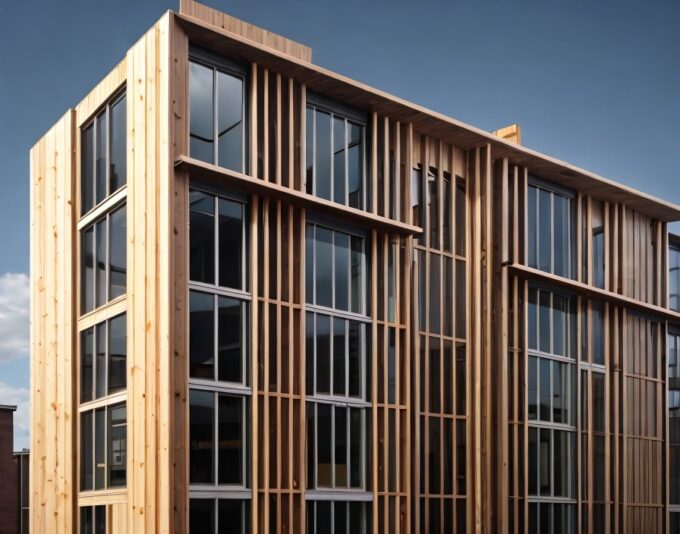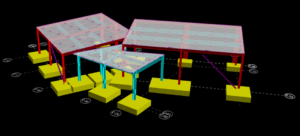Introduction
Cross-Laminated Timber (CLT) is transforming the construction industry with its strength, sustainability, and versatility. Builders increasingly rely on this engineered wood product in both commercial and residential buildings. However, designing the CLT structure for safety, performance, and regulatory compliance necessitates the involvement of a licensed professional engineer.
What is Cross-Laminated Timber (CLT)?
CLT is an engineered wood panel. Manufacturers stack layers of solid-sawn lumber boards crosswise and bond them with structural adhesives. This cross-laminating process enhances strength, stability, and rigidity. Furthermore, CLT is suitable for floors, walls, and roofs in commercial buildings. Similar mass timber systems include NLT (Nail Laminated Timber), DLT (Dowel Laminated Timber), and MPP (Mass Ply Panel).
Key Benefits of Cross-Laminated Timber (CLT):
-
Sustainability:
- Renewable Resource: CLT is made from sustainably harvested wood, which is a renewable resource. It contributes to lower carbon emissions compared to traditional building materials like steel and concrete.
- Carbon Sequestration / Carbon Capture: Moreover, wood naturally sequesters carbon dioxide, helping mitigate climate change. CLT buildings can store significant amounts of carbon throughout their lifecycle.
-
Structural Performance:
- Strength and Stability: The cross-laminating process gives CLT panels exceptional strength and dimensional stability. Therefore, they are suitable for load-bearing structures.
- Seismic and Fire Resistance: CLT structures have demonstrated good performance in seismic events due to their flexibility and light weight. Additionally, CLT has predictable fire performance. Char layers form on the surface, protecting the inner layers.
-
Construction Efficiency:
- Prefabrication: Manufacturers prefabricate CLT panels in controlled environments. This ensures high precision and quality. Prefabrication reduces construction time and waste on-site. Workers can pre-cut openings for MEP systems in the factory are prefabricated in controlled environments, ensuring high precision and quality. Consequently, this reduces construction time and waste on-site.
- Speed of Installation: CLT panels are relatively lightweight and quickly assembled on-site, speeding up the construction process and reducing labor costs.
-
Design Flexibility:
- Versatile Aesthetics: CLT offers aesthetic versatility, allowing for exposed wood finishes that enhance the visual appeal of commercial spaces.
- Adaptability: CLT is used in a variety of building types and designs, from low-rise to mid-rise buildings, and even in hybrid structures combining different materials.
Why Involve a Licensed Professional Engineer?
-
Technical Expertise:
- Structural Analysis: A licensed professional engineer conducts detailed structural analyses. They ensure CLT components withstand all applied loads.
- Material Properties: Engineers understand the specific properties of CLT and can optimize its use in the building design for maximum efficiency and safety.
-
Regulatory Compliance:
- Building Codes: Licensed engineers are knowledgeable about the latest building codes and standards, ensuring the CLT structure complies with all relevant regulations.
- Permits and Approvals: Additionally, engineers can prepare the necessary documentation and calculations for obtaining permits and approvals from regulatory authorities.
-
Safety and Reliability:
- Load Calculations: Engineers perform accurate load calculations and stress analysis. Thus, they ensure that the CLT structure can safely support the intended loads, including dead loads, live loads, wind loads, and seismic forces.
- Risk Mitigation: Engineers identify and mitigate potential risks, ensuring the long-term durability and safety of the building.
-
Quality Assurance:
- Design Optimization: Professional engineers optimize the design for efficiency, cost-effectiveness, and performance. They ensure that the CLT structure meets the highest standards.
- Construction Oversight: Engineers oversee construction, ensuring that the CLT components are installed correctly and according to the design specifications.
Conclusion
Cross-Laminated Timber (CLT) offers numerous benefits for commercial and residential building design, including sustainability, structural performance, construction efficiency, and design flexibility. However, a licensed professional engineer must design the CLT structure to fully leverage these advantages and ensure the building’s safety and reliability. Their expertise ensures compliance with codes and standards, accurate structural analysis, and optimal design. For your next project, consider CLT and reach out to our team of experts at EVstudio. We are here to help!











